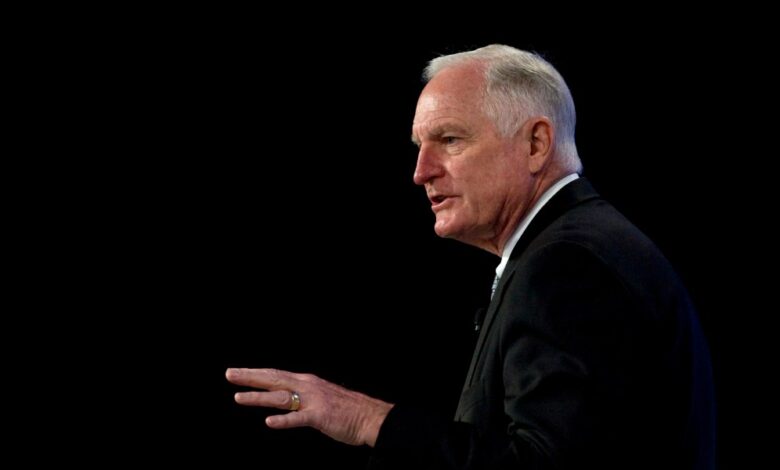Former Intel CEO Craig Barrett: Splitting up the leading US chip manufacturer is a bad idea


Throughout the 59-year history of Moore’s Law, the only consistent truth in the semiconductor industry is that efficiency wins. Competitors come and go, and new technologies like PCs, smartphones, and artificial intelligence quickly change the landscape. But in the end, the company with the best technology and the ability to produce in large quantities wins the prize.
For decades, this was Intel. The company’s mantra is to promote technological leadership at all costs and push Moore’s Law to the limit. That’s how Intel became the most successful semiconductor company on the planet, with manufacturing technology that’s always a generation (about two years) ahead of other companies.
Over the past decade, that has all changed. Intel stumbled and lost its leadership position—and now Intel is seen by some as just another company struggling to survive.
Some experts say there is a simple solution: split the company into two. That way, their argument is that design company Intel can compete with other chip designers (AMD, QualcommNVIDIA, etc.) while the company’s foundry division can freely serve all chip designers. This simple solution ignores the existence of Moore’s Law—and would be bad for Intel and the United States.
Every design company wants the best manufacturing technology available to maximize chip performance. This is true for companies that sell chips on the open market as well as those that design for internal use such as Apple And Amazon. Whichever foundry has the latest and greatest technology will win the majority of a chip designer’s business. Today, that position is held by TSMC. Much of the industry depends on the same manufacturers to make their products—their only manufacturing advantage is TSMC’s technological leadership.
Intel can attract these chip customers by restoring its chip technology leadership. Even if you compete with Intel’s designs, why put yourself at a disadvantage? As long as Intel has the best technology and is able to compete on price, the competition problem can be solved.
All of this is happening at a time when the world needs a more diverse and resilient global semiconductor supply chain. Geopolitical tensions around the world are escalating, making the urgent need for robust U.S. manufacturing capacity on our shores even more urgent.
Splitting Intel into two separate companies would not benefit the United States if Intel’s design business succeeds but its chip manufacturing business does not. In that case, the United States would still be dependent on a foreign supplier for advanced technology – and $50 billion in the CHIPS ACT would be wasted.
We have seen this movie before. Years ago, struggling AMD had to spin off its manufacturing capabilities into Global Foundries. Experts welcomed the split at the time. A decade later, AMD is doing well using TSMC, while Global Foundries has little differentiating technology. Global Foundries did not have a sufficient research and development (R&D) budget, and with limited output and revenue, it struggled to keep up with the market leaders.
The economic reality is that massive investment is needed to advance Moore’s Law. In today’s semiconductor industry, there are only three companies (Intel, SAMSUNGand TSMC) have enough revenue to vie for technological leadership. If you split Intel, the fab would likely fail due to reduced R&D spending coupled with the complex realities of breaking up a giant multinational amid a multiyear turnaround effort.
Instead of wasting time and effort splitting Intel into two separate companies, why not focus on the real problem? The Intel of tomorrow needs to be like the Intel of 15 years ago—the leader and leader of Moore’s Law. That way, you get a win-win scenario with US-based design and manufacturing technology.
This starts with rebuilding Intel’s technology leadership. The current CEO, Pat Gelsinger, has exactly the right strategy and ethos, and he is driving the right changes.
Intel is on track to achieve unprecedented node growth to catch up with TSMC. It is already at the forefront of next-generation technologies that will shape the semiconductor industry for years to come, such as high NA EUV lithography and back-end power delivery. Yes, more needs to be done but this is a good start and they must continue.
The US government must also do its part. This includes increasing funding for pre-competitive basic research in semiconductor technology at our research universities and national laboratories. The United States has taken a small step in this direction with the establishment of the National Semiconductor Technology Center, but there is still a long way to go, especially when you consider that the five-year NSTC budget is less than Intel spends every year on R&D.
There are enormous challenges as leading manufacturers race to create technology that combines 100 billion transistors into a piece of silicon the size of a fingernail. These are the most complex things humanity has ever built, and semiconductor industry leaders will spend tens of billions of dollars to make it happen.
Let’s not kid ourselves: If America wants to be the leader in this game again, splitting Intel in half is not the solution. We must be willing to invest and work hard to carry Moore’s Law into the future, not waste time rearranging folding chairs.
I remember a similar moment in Intel’s history – the dot-com bubble collapse in the early 2000s. Customer demand evaporated. Wall Street says we should lay off workers, close factories, and cut R&D spending. Intel’s board of directors is very troubled by this situation but still follows the management’s plan to maintain investment in R&D and building new factories. The stock price slumped, but when demand returned, Intel was in a stronger position than before. It’s not pretty but it’s the right thing to do. Pat Gelsinger is doing the right thing now.
More must-read comments published by Luck:
The views expressed in Fortune.com reviews are solely those of the author and do not necessarily reflect the views and beliefs of Luck.
Data sheet: Stay at the forefront of the business of technology with insightful analysis of the biggest names in the industry.
Register here.




